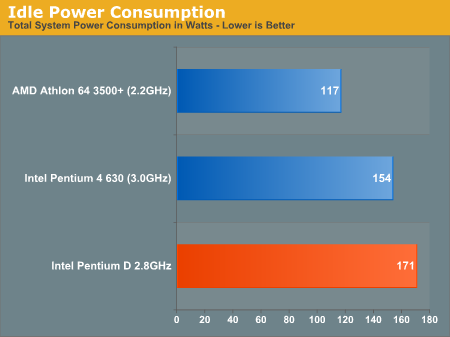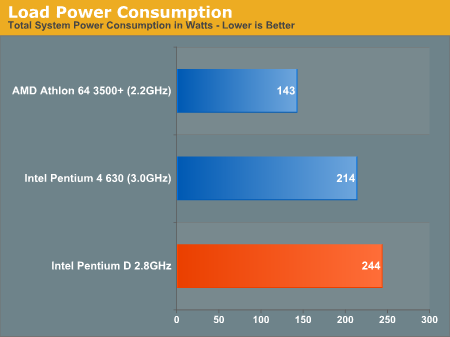Intel Dual Core Performance Preview Part II: A Deeper Look
by Anand Lal Shimpi on April 6, 2005 12:23 PM EST- Posted in
- CPUs
I'll admit, dual core has me excited for many of the reasons outlined in Part I. A big part is that personally, I've been using multiprocessor systems in my main computer for years. I've always appreciated the benefits of multiprocessor platforms, but recommending one for a desktop user has never been really feasible. Even the cheapest 2P workstation motherboards were at least twice the price of a desktop motherboard, not to mention the cost of the CPUs. The mass market had a short affair with multiprocessing in the days of the ABIT BP6 and the Celeron 300A, but in the grand scheme of things, that was barely a blip on the radar. Now, for the first time, both AMD and Intel are ready to bring the type of robustness of multiprocessor platforms to the desktop with their dual core offerings.
Part I focused on what dual core can offer, but now it's time for a much more practical look. We've never recommended Intel's Extreme Edition line of processors nor AMD's FX series, both supposedly marketed to gamers, but not purchased by any of our gaming readers. The processors that we recommend are usually much better values for the price, and thus, today's comparison isn't based around the most expensive dual core offerings, but rather the cheapest.
A point we made in the first article was that Intel's pricing strategy for dual core is extremely aggressive, with the cheapest 2.8GHz Pentium D soon to be introduced at $241. The problem is that at only 2.8GHz, the Pentium D won't have the strongest single threaded performance, which puts buyers in a sticky situation - do you buy an Athlon 64 3500+ for great single threaded performance or will the Pentium D give you a better overall multitasking experience? Intel doesn't do much to complicate the situation, as the Pentium D 2.8GHz will be close in price to the Pentium 4 630 (3.0GHz), which isn't much of a clock speed advantage. AMD will eventually have competitively priced dual core parts, but right now, AMD doesn't appear to be looking at the mainstream desktop market for dual core Athlon 64 chips.
The three chips mentioned above are the basis of the majority of today's comparison, but the decision is far from clear cut. Let's find out why.
Power Consumption
We'll start with power consumption - the contenders? A 90nm Athlon 64 3500+ vs. the Pentium 4 630 and the dual core 2.8GHz Pentium D. As always, we measured total system power at two states: idle and under a full load. For our full load test, we used a multithreaded application, 3ds max 7, performing the CBALLS2 render test from the SPECapc benchmark.


The K8 architecture simply lends itself to lower power consumptions than Intel's high frequency approach to computing with the Pentium 4 (especially Prescott). The move down to 90nm really reduced AMD's power consumption a lot, to the point where the 90nm Athlon 64 3500+ actually consumes less power under full load than the Pentium 4 630 at idle.
The Pentium 4 vs. Pentium D comparison is also interesting, as the 2nd core doesn't add all that much to overall system power consumption. In this case, we're looking at an increase in overall system power consumption by less than 15%. Intel still doesn't win in the power consumption department though; if you want something cool and quiet, AMD is still the way to go.
The Test
Our hardware configurations are similar to what we've used in previous comparisons.
AMD Athlon 64 Configuration
Socket-939 Athlon 64 CPUs
2 x 512MB OCZ PC3200 EL Dual Channel DIMMs 2-2-2-10
NVIDIA nForce4 Reference Motherboard
ATI Radeon X850 XT PCI Express
Intel Pentium 4 Configuration
LGA-775 Intel Pentium 4 and Extreme Edition CPUs
2 x 512MB Crucial DDR-II 533 Dual Channel DIMMs 3-2-2-12
Intel 955X Motherboard
ATI Radeon X850 XT PCI Express










106 Comments
View All Comments
stephenbrooks - Wednesday, April 6, 2005 - link
#55 yes, that would be my best bet on what Anand was implying. AMD's 90nm process is impressive on power efficiency.bdchambers79 - Wednesday, April 6, 2005 - link
Hmm... if permormance isn't the only metric for dual-core AMD, then perhaps power also plays a role? What if they could craft a 2.2gHz monster that had the same power draw as a 2.0gHz a64? Such a beast, besides being a processing power-house, would show extreme overclock potential.cHodAXUK - Wednesday, April 6, 2005 - link
'The move down to 90nm really cut down AMD’s power consumption a lot, to the point where the 90nm Athlon 64 3500+ actually consumes less power under full load than the Pentium 4 630 at idle.'ROFL, I expect the old Prescott space heater gags to start again after this review :)
Crassus - Wednesday, April 6, 2005 - link
Hey Anand,on page 13 top diagramm it says "Thanks to DVD Shrink behaving and running with a low priority, our gameplay was largely unaffected on the Athlon 64. The performance dropped less than 3% in Doom 3. ..." yet the graph shows the A64 at the bottom far behind the Pentiums. Is the graph messed up or the comment?
Great article though and thatnk you for listening to your readers.
Thanks also for the NCQ-page. I still wonder if you want to pick up where you left off some months ago and look into RAID in more detail, possible measuring the impact of NCQ on the benefits of SMT or vice versa and CPU-load issues with simple RAID5 setups on dual-core?
Cheers, Crassus
Lonyo - Wednesday, April 6, 2005 - link
#50 and JeffLet's just say that the dual core Athlon 64 running at 2.2GHz won't be compared to a dual core Pentium D running at 2.8GHz.
AMD's dual core will be quite impressive, even more so than Intel's. Don't look at performance as the only vector to measure though...
....PRICE.
I think you were spot on. 2.2GHz DC Athlon is almost certain NOT to compare to PD2.8GHz.
The article is comparing 3 systems with the same price processor.
The comments from Anand suggest that the 2.2GHz AMD DC will blow the 2.8GHz PD away, but at a higher price.
The 1.8GHz AMD DC is more likely to be comparable (and possible faster, if the 2.2GHz Athlon really is amazing). But who knows?
coldpower27 - Wednesday, April 6, 2005 - link
Tomshardware was able to overclock the Pentium EE 3.2GHZ Dual Core to 3.8GHZ, and 4GHZ on some exotic form of cooling.coldpower27 - Wednesday, April 6, 2005 - link
Rumors indicate AMD's aiming for a launch at 1.8GHZ - 2.2GHZ frequencies for the Athlon 64 Dual Cores, I would guess, that most likely that these Dual Cores are based on the San Diego cores, as they each have access to 1MB of cache with a die surface area slightly larger then Clawhammer.Another guess would be they would use the 2.2GHZ Dual Cores as their FX flagship and have the 1.8GHZ/2.0GHZ variants as their mainstream line.
However with AMD saying 2H 2005 for their Dual Cores, we won't have to wait too long then for Intel's new version of Dual Core in 1H 2006 on the 65nm process.
Maybe the 2.2GHZ Athlon 64 Dual Core is much more expensive then the 2.8GHZ Pentium D? Or it competes with Intel's Pentium D 3.2GHZ.
defter - Wednesday, April 6, 2005 - link
Great review! It is refreshing to see different kinds of benchmarks.The problem with dual core Athlon64 is that it won't be launched until 2006 according to the AMD's roadmap: http://www.amd.com/us-en/Processors/ProductInforma... (dual core Athlon64 FX will be launched in H2 2005, but no regular dual core Athlon64 is scheduled for 2005)
And in 2006, Intel will have 65nm dual core chips available...
PrinceXizor - Wednesday, April 6, 2005 - link
For those saying that Intel will have ANOTHER dual core system out because of the delay by AMD...remember...this was a technology PREVIEW. There is no released hardware yet.Its going to be interesting to see what the benefits of AMD's built from the ground up to be multi-core approach vs. Intel's patch job (I still have utmost respect for Intel, they created one fine "patch job" under a severe time constraint, sometimes it does pay to be a behemoth ;)) will be.
P-X
NetMavrik - Wednesday, April 6, 2005 - link
Don't take this post the wrong way, I am not knocking Intel's HyperThreading, but I think most people have actually forgotten what it is. It is not a feature of the Pentium 4, but a bandaid approach to keep their now 31 stage pipeline busy doing something. The reason that a 3.8GHz P4 doesn't run circles around a 2.6GHz A64 is that horribly designed 31 stage pipeline. AMD can't implement some form of HyperThreading because it doesn't have a bunch of processor stages sitting around doing nothing like a P4 does without HyperThreading.